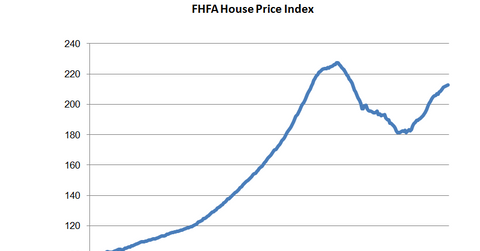Must-know: Why home-price appreciation is leveling off
In July, home prices increased 0.1% month-over-month. They’re up 4.4% year-over-year (or YoY). Prices are now within 6.5% of their April 2007 peak. They correspond to the levels in July 2005. Real estate values drive consumer confidence and spending. They have an enormous impact on the economy.
Nov. 20 2020, Updated 3:12 p.m. ET

The Federal Housing Finance Agency’s (FHFA) House Price Index
The FHFA House Price Index (or HPI) differs from the other house price indices—like Case-Shiller and Radar Logic. HPI only looks at houses with mortgages guaranteed by Fannie Mae and Freddie Mac. This means the home prices are below the conforming threshold—$417,000. It also means the borrower has a mortgage that eliminates cash-only transactions. Finally, the FHFA HPI eliminates jumbos. This makes it more of a central tendency index.
In July, home prices increased 0.1% month-over-month. They’re up 4.4% year-over-year (or YoY). Prices are now within 6.5% of their April 2007 peak. They correspond to July 2005 levels.
Real estate values drive consumer confidence and spending. They have an enormous impact on the economy. The phenomenon of “underwater” homeowners—homeowners who owe more than their mortgage is worth—has been a major drag on economic growth. Underwater homeowners are reluctant to spend. They can’t relocate to where the jobs are. So, real estate and mortgage professionals watch the real estate indices closely.
Real estate prices also drive credit availability in the economy. Mortgages and loans secured by real estate are major risk areas for banks. When real estate prices start falling, banks become conservative. They reserve funds for losses. Increasing real estate prices makes the collateral worth more than the loan. This encourages banks to lend more.
Implications for the homebuilders
Rising real estate prices are helpful for builders like Lennar (LEN), PulteGroup (PHM), D.R. Horton (DHI), and Toll Brothers (TOL). The prices make it possible for them to raise prices and increase their gross margins. That said, it appears buyers are beginning to experience sticker shock. Prices and mortgage rates increased over the past year. Builders are noticing a drop-off in traffic. This could mean the days of double-digit average selling prices (or ASPs) are over.
Investors who are interested in trading in the homebuilding sector should look at the S&P SPDR Homebuilder ETF (XHB).
